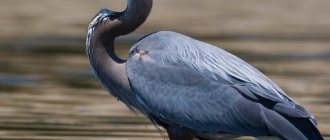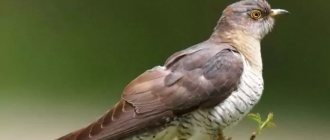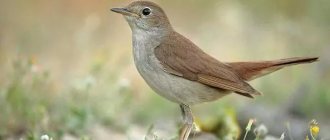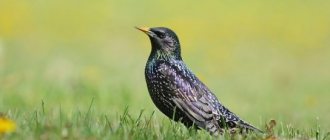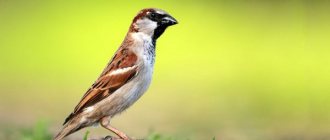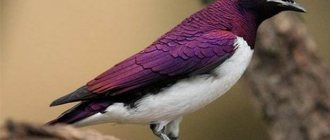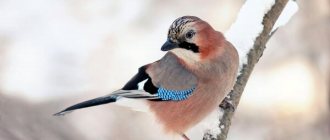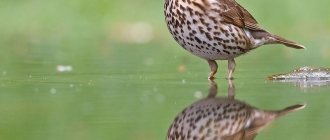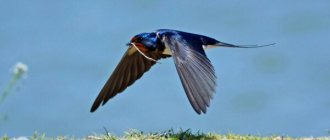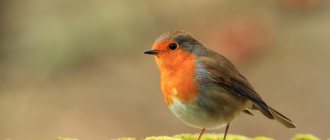Today we will talk about how to distinguish a thrush from a starling. The two feathered brothers belong to the order Passeriformes, belong to the song breeds, both have a yellow beak, and both live in almost all corners of the globe. An ignorant person, seeing one of them on a tree, may not understand who exactly is in front of him. Read the article and find out how they differ in appearance, diet and lifestyle, and what other birds are similar to them.
Description of the bird
Starling songbirds belong to the Starling family of the order Passeriformes. They not only sing melodiously and are distinguished by the abilities of mockingbirds, but also destroy insects, for which they are loved in all corners of our planet where they were brought by humans.
There are about 10 species of starlings, which differ mainly in the regions of their residence. The most famous of them is the common starling, a resident of Eurasia.
— Advertising —
Starlings are thrush-sized birds with a long, straight beak with a slightly flattened tip, a short tail and sharp wings. Their plumage is predominantly black with white patches and a characteristic multi-colored tint.
general characteristics
Externally, starlings are somewhat similar to blackbirds: they have almost identical sizes, similar color of plumage and beak. Adult starlings can reach sizes of about 20 cm in length, and their wingspan will be approximately 40 cm. The weight of the birds will be only 70 grams. For their parameters, starlings have a fairly massive body, and their characteristic difference from blackbirds is the presence of a short tail and various light specks present on the color.
Light inclusions become especially noticeable in females at the beginning of spring. However, closer to autumn, this distinctive feature disappears.
Starlings have a rounded head, and its size is proportional to the size of the body. The birds' feet are red-brown. During the mating season, the beak turns yellow, at other times it is black.
The beak is quite long, its size is 2-3 cm, it is sharp, and has a somewhat curved appearance.
Juveniles can be distinguished by their brown beak and plumage, which lacks the characteristic glossy effect. Their wings have a rounded shape, and the area near the throat is lighter than that of adult starlings.
All members of the family are classified into several varieties based on their habitat, which also affects the characteristic metallic sheen. Thus, among European starlings the standard is considered to be a mixture of green and purple in shade, while for other subspecies it is a combination of bronze and blue.
The metallic tint in the plumage is not due to the presence of a coloring pigment, but to the specific structure of the feathers. When the angle of inclination changes, the tone also changes, which creates a variety of shades.
Birds molt once a year, towards the end of summer, when the breeding season ends.
What does it eat?
Starlings are omnivorous birds that find their food depending on the time of year.
In spring, they prefer animal food - earthworms, insects and arthropods (spiders, caterpillars, butterflies, grasshoppers). In summer and autumn, they willingly eat plant food: fruits, vegetables, berries, seeds.
— Advertising —
Starlings can use their large and strong beak as a kind of lever to open fruits protected by a hard peel or shell.
Reproduction of starlings
In the spring, male starlings return from wintering, actively dividing territory, looking for nesting sites and honing their vocal abilities. They prefer to make nests in hollows, which is why birdhouses have become popular. The newly-made pair builds a nest together.
During the season, females make up to three clutches, but due to the long break between them, pairs often break up and form new ones. One clutch contains up to 7 bluish eggs, which hatch in about 2 weeks. Both parents incubate and feed the chicks.
When offspring appear, starlings are always near the nest and also forage for food nearby. At first they select soft food, and gradually move on to coarser ones. After 3 weeks, the chicks can leave the nest.
Photo: club.foto.ru
Cuckoo (50 photos): description of the bird, habitat and what it eats
Habitat and distribution area
The distribution range of starlings is very wide. Each species has its own characteristics in distribution, and in general, the natural habitats of these birds include all regions of Europe and Asia, as well as North Africa.
Certain species of starlings were brought by humans to North and South America, Australia and New Zealand. The spread of starlings was facilitated primarily by their reputation as excellent pest fighters.
Starlings inhabit the plains and rarely climb the mountains. They willingly choose housing close to a person.
Departure for the winter
Starlings winter in Central or Southern Europe, as well as in Asia, India and North Africa. Obeying instinct, they yearly return to the place where they were born and first saw sunlight. In this they are very similar to swallows .
Sometimes starlings have to fly over 3 thousand miles, including over the Mediterranean and Black seas. They can cover up to 80 miles per hour, making only 2-3 stops a day.
According to eyewitnesses' descriptions, when meeting sea vessels, these birds seek protection from people and descend in clouds onto the decks. After all, during hurricanes the entire flock can die.
According to old legends, ships on which at least one bird was killed seeking shelter are in danger of imminent death.
Interesting! The departure time of starlings coincides with the beginning of September, although in warmer regions this time may shift to mid-October.
These birds return to their homeland quite early. The first time after arrival, starlings, like swifts , stay in flocks. Their arrival is a special sight.
One flock can contain several thousand birds. Flying high in the sky, they make synchronized movements. You can see what these celestial acrobats look like in the photo below.
flock of starlings
According to the description of ornithologists, in all species of starlings, the scout males are the first to return. The females arrive a little later, about a week later, at a time when their partners have already chosen nesting sites.
If the male looking after the nest fails to find a mate in time, he is left alone.
Interesting! After the chicks of the second clutch leave the nests, the starlings gather in flocks again. They can spend the night on several nearby trees. Moreover, starlings perfectly sense any weather changes. If they gather in small flocks and begin to “lead” round dances, it’s bad weather.
Is the starling a migratory bird?
The starling's migration directly depends on its habitat. All birds living in the northern regions migrate south for the winter and are considered migratory birds. Their migration begins in September-October, and the distance that starlings travel reaches 2,000 km. Birds return to their native lands at the end of March or in April.
Starlings, which live in southern Europe and Asia and Africa, are sedentary birds.
Lifestyle and behavioral characteristics
Starlings prefer to live in large flocks, the number of which depends on the time of year. Sometimes flocks become so large that during movement they resemble a dense sphere, the diameter of which narrows and expands. The behavior of the flock is not controlled by a clear leader; all its members can influence the trajectory of movement, setting a new rhythm for their neighbors. Such large aggregations help small starlings protect themselves from birds of prey like hawks.
A flock of starlings gathers in the sky
When dusk comes, starlings form large groups and in this composition go to roost for the night. They can sleep in trees, reeds or bushes. In addition, at night you can often find starlings in parks located in cities or in gardens. They also choose coastal areas for spending the night.
Sometimes it happens that starlings, gathering in forest parks, can form flocks, the number of which reaches several hundred thousand individuals. This is a big problem for both people and the environment. The droppings from such huge flocks accumulate on the ground and, due to their toxicity, worsen the environmental situation.
Large concentrations of starlings, united in one flock during migration, are called “black suns”.
Starlings are excellent sound mimics and can reproduce various sounds and even songs. To remember, they only need to hear the melody once. The more mature a bird is, the richer its repertoire.
In nature, females usually choose males who know a large number of songs, which indicates their experience.
Starlings' songs quickly replace each other, with virtually no pauses between them. Birds can imitate the singing of other birds, creaking, the sound of metal, the sound of a car. In general, the repertoire can consist of approximately 30 song compositions. Most often, their birds display them at the onset of the mating season, trying to attract a partner and drive competitors away from the territory.
Elena
Ask a Question
Question to the expert
Are starlings migratory birds?
The phenomenon of migration in starlings completely depends on the regions in which these birds live. Thus, those starlings that live in the northern regions migrate to warm countries and are classified as migratory birds. Their migration is caused not only by low temperatures, but also by the lack of food, which is difficult to find in the harsh northern conditions. Migration time occurs from September to October. Typically, birds have to travel about 2,000 kilometers before they reach their destination. They return to their usual habitats only at the end of March. Starlings, which live in southern Asia and Europe, and also occupy territories in Africa, belong to the category of sedentary birds and do not migrate for the winter.
Social structure
Starlings form large flocks, in which each individual creates its own pair. Birds usually have established monogamy, but sometimes polygamous couples are also found. Since birds live in colonies, all their nests are located close to each other.
If the family is polygamous, the male mates with another partner while the first “wife” is busy planting the eggs. At the same time, the reproductive potential of the second family is lower than that of the first.
Starlings in flocks do not have clear leaders. Despite this, the birds are quite united and know how to get along in a group, which helps them protect themselves from predators.
Starlings remain vigilant even on vacation
Kinds
Common starling
The bird is up to 22 cm in length with a wingspan of about 38 cm and weighs 70-80 g. The long and sharp beak is slightly curved downwards. The color of the back and belly of females and males is no different: black plumage with a metallic sheen of purple, green, blue or brown. The species is distributed throughout Eurasia.
Brahmin Starling
The species lives in southern Asia. This is a bird 20 cm in length, with a wingspan of up to 12 cm and weighing about 50 g. The back of the bird is brownish-gray, the breast and belly are beige-brown. The head is decorated with shimmering black feathers that form a crest. The beak is yellow. Sometimes the Brahminy Starling is confused with the Pink Starling, but it differs in that it does not have black feathers on its chest.
Cambodian starling
The body length of birds is up to 25 cm. The plumage of the head, neck and chest is light brown. The belly is pink-gray. The back is dark gray, sometimes with a slight metallic tint. The species lives in the countries of Indochina, including Myanmar, Thailand, Vietnam, Laos, and Cambodia.
Red-billed Starling
Lives in the south and west of China. It reaches 20-24 cm in length. Males have a white head and abdomen with a brown or gray tint. The chest, back and sides are dark gray. The plumage of the tail and wings is black with a green, blue or purple metallic tint. The beak, according to the name, of this species is red.
Piebald starling
The main habitat of this species is south and southeast Asia. The bird is similar to the black-necked starling, but smaller in size. The male and female are very similar. The plumage of their head, throat, chest and back is black. The cheeks and lower body are white and gray. The wings and tail are brown-black with white feathers. The beak is orange-red.
Pastor
The species reaches a length of 22 cm, a wingspan of up to 14 cm, a weight of 60-90 g. It is distinguished by its contrasting unusual plumage: black with a metallic sheen on the head, neck and chest and pastel pink abdomen and back. On the head there is a crest of long feathers. The beak is thicker and shorter compared to the common starling. The pink starling lives in southeastern Europe and Central Asia.
Grey-headed Starling
This relatively small species lives in India and China. The body length reaches 22 cm, weight - 45 g. The bird's head is white-gray, the cheeks and back of the head have a silvery tint. The beak is interesting: blue base, green middle and yellow tip. The back is brown-gray, the belly is brown.
gray starling
A songbird with a body length of up to 25 cm. Resident of East Asia. The breast, abdomen and rump of this species are light gray in color. The feathers on the head are streaked with black and black-brown; there are tufts of white feathers on the cheeks. The beak is yellow-orange with a dark tip.
Black-winged Starling
The species lives on the islands of Java and Bali in Indonesia. Its body length is 22-24 cm, its wingspan is up to 130 cm. The color of the plumage of this species is mainly white, except for black wings and a tail with a white stripe at the end. The feathers on the head are brown in color and form a crest at the back of the head. The beak and legs are yellow.
Black-necked Starling
One of the largest representatives of the starling species with a body length of up to 30 cm and a wingspan of up to 16 cm. Distributed in southeast China, Myanmar, Thailand, Laos, Cambodia and Vietnam. The back, tail and wings are black with white patches, the head and belly are white. On the neck there is a collar of black shiny feathers.
Black starling
Inhabitant of Europe and North Africa. Bird dimensions: 19-22 cm in length, 13-14 cm wingspan, 80-115 g weight. The species is very similar to the common starling. The predominant color of its plumage is black with a metallic tint of purple or green. The tail is short and straight. The beak is sharp and long, curved downwards.
Blackbird and black starling: what are the differences
The blackbird and black starling are most similar to each other. The first inhabits forests, ravines, gardens and parks throughout Europe, as well as Russia, and forests on the slopes of the Caucasus mountains. Of the entire thrush family, the black one is the largest representative. Its plumage is black, shiny, glossy, its beak, legs and eye circles are bright yellow. The female thrush is brown with a dark tail and light breast.
The bird feeds on everything it finds in the forest: berries, seeds and insects. It looks for food by jumping on the ground, peers into the ground, and scours the bushes in search of something sweet.
The black starling is rarely seen, it is half the size of a blackbird, the plumage is generally similar, but long feathers grow on the throat in the spring. During the cold season, white specks appear on the head. The beak is yellow only during the mating season, in other seasons it is dark brown.
The bird lives in southern Europe, North Africa, North America and on some Mediterranean islands. Nests are built in olive and orange groves, parks, vineyards, and sometimes under the roofs of houses.
Male and female: main differences
Sexual dimorphism in all starling species is rather weakly expressed. So, for example, the male and female common starling differ in the feathers on their chest - in females they are more graceful and shorter. In addition, females have red dots at the base of the beak, while males have a blue spot.
In other species, females and young are slightly lighter than male starlings.
Reproduction and raising of offspring
The breeding season begins in spring and continues until summer. Once the males have teamed up with their mates and finished building the nest, the breeding phase begins. Females form clutches within several days. Usually you have to hatch about five eggs. The eggs laid are blue in color and measure about 3 cm long and 2 cm wide.
The male and female take turns incubating the eggs for two weeks. However, the female always remains close to the eggs at night.
Newborn chicks appear blind and without feathers. The first fluff is formed only after a week of life, and the eyes open on the ninth day. At first, starlings constantly remove droppings from their home so that the resulting moisture does not affect the well-being of the offspring.
Hatched chicks
Small chicks live in the nest for about 20 days, during all this time the parents obtain food for them and take care of their condition. Even after the offspring flies away from the nest, the parents continue to feed the children for 14 days.
In northern latitudes, only one clutch of eggs is usually formed in one season. In the south, this figure ranges from 2 to 3 broods.
Females who find themselves without a partner can lay eggs in other nests. The emerging chicks often displace the offspring of others, and other starlings are engaged in feeding the foundlings.
Peculiarities of the mating season among starlings
The mating season begins in early spring. If starlings migrated in winter, then this moment occurs immediately after their arrival in their native land. The duration of the mating season depends on feeding conditions, food availability and climatic features of the area. The first clutch begins simultaneously for all starlings, since families usually live nearby. The second clutch most often occurs due to the tendency of starlings to polygamy and occurs among those females who, for some reason, did not have a partner in early spring.
Question to the expert
How long is the life expectancy of starlings?
The lifespan of birds in the wild is about 12 years. At the same time, there are cases where starlings in captivity lived for more than 20 years.
Caring for the Cubs
After the eggs have been laid, in about 11-14 days the shell will break and the babies will be born. They are still completely helpless, and therefore the first food that their parents bring is usually very soft. As the chicks grow older, their type of food also changes, and after a few weeks they can eat everything the same as their parents. Approximately 22 days after birth, the strong chicks begin an independent life and fly away from the nest.
This is how the grown chicks are fed
Keeping at home
In captivity, a starling will need a cage with a minimum size of 70 cm by 30 cm by 45 cm with a separate container for bathing and drinking, as these birds love to swim. The water is changed daily.
What to feed
Birds are absolutely unpretentious in nutrition. The diet is often based on a nightingale mixture of grated carrots, eggs and white crackers. They also add fish food (daphnia, gammarus), meat (pieces of chicken or beef), plant and grain seeds, vegetables (everything except legumes and potatoes), herbs, pieces of fruit and berries.
The only downside to keeping these birds is their sloppiness. Starlings are truly dirty, you need to clean up after them often.
The most obvious differences between the two birds
In addition to external differences, the starling and thrush differ in other parameters:
- Diet: the blackbird in the summer is a real scourge for a summer resident; it eats all the crops and spoils fruits and berries. Starlings love insects; with their hard beaks they are able to crush the shells of beetles that spoil agricultural land.
- Reproduction: male starlings, having set up a home, begin to sing trills, attracting a female. With blackbirds, everything is different - the female builds the nest herself, after which the male comes to her and fertilizes her.
- Eggs: The female thrush lays up to six bluish-green eggs at a time, fertilization occurs twice per season. Starlings can give birth three times over the summer; their eggs are pale blue in color.
- Raising offspring: the starling's eggs are incubated by the female, and occasionally replaced by a male. After 11-13 days, the chicks hatch and are fed 10 times a day from both parents for two weeks. Blackbirds feed their chicks 200 times a day, and both parents also do this. Interestingly, by the time they become independent, half of the brood dies.
- Nesting: blackbirds are shy and afraid of people, so they choose secluded places for their home in broad-leaved or coniferous places, closer to water bodies. Their brothers, on the contrary, choose places in the crevices of walls or occupy old alien nests.
It is interesting that in the thrush only the female takes care of household chores, while in the starling both future parents are involved.
Interesting Facts
- In nature, starlings live up to 12 years, and in captivity - even up to 20 years;
- Starlings are very aggressive towards other bird species, and can displace species from their usual habitats, as, for example, happened in North America during the conflict between the starling and the green woodpecker;
- Starlings are known as pest fighters, but they can also cause harm to humans - destroy crops of grain plants and vineyards;
- Starlings like to live in large flocks; during migration, several thousand individuals can gather together for the night.
- The synchronized migration of large flocks of starlings is called murmuration. This is a very beautiful and fascinating phenomenon - many birds seem to dance in the air, forming various intricate figures that decrease and increase in the sky. Murmuration remains a mystery in bird behavior for scientists today. This process cannot be reproduced even with the most modern technology.
Harm from starlings
Starlings have ambiguous relationships with people. On the one hand, a smart bird can become a wonderful companion. On the other hand, the damage to agricultural land from just one swarm is truly destructive. They also create emergency situations at airports. They also displace other beneficial birds from inhabited areas.
Photo: pixabay.com
Nightingale (60 photos): description, habitat and what it eats
Singing
Starlings are not only distinguished by their own ringing iridescent trills, which consist of whistling, creaking, hissing sounds, but are also excellent mockingbirds. Perhaps there is no melody that a starling could not reproduce. The song of a thrush, oriole, swallow, lark or jay - the starling can perform any song.
Moreover, the starling can eavesdrop and perfectly copy melodies from the life around him - the croaking of frogs, the barking of dogs, the bleating of sheep.
And at home, a starling can not only be tamed, but also taught to speak short phrases and tongue twisters.
Chants
As soon as the air warms up a little in the morning, these birds sit on high branches and begin their entertaining concert. The fact is that all types of starlings are mockingbirds and are able to imitate any tune of their relatives.
Starling singing
Their song is a whole set of melodies, consisting of nightingale melodies, the sharp sounds of orioles, the subtle whistling of tits, the ringing beat of a stork, and even the croaking of frogs or meowing.
However, birds are able to repeat any sounds heard near the nest: the croaking of frogs, meowing, or even the creaking of a saw or cart.
In captivity, even young individuals quickly begin to imitate human voices, like parrots or jays . Ornithologists believe that they also have their own motive - a long, sharp whistle, which is innate.
Advice! It is quite easy to tame a starling. If you throw worms or crumbs to a bird, after a while it will fearlessly take food directly from your hands.
Communication and perception
Common starlings are very vocal throughout the year, except during molt when they remain silent. The songs of males are very diverse and consist of many components. They gurgle, whistle, squeak, chirp and click.
Photo: Jarvo
Starlings are also excellent imitators, often copying the songs or sounds of other birds and animals (goats, amphibian toads, cats) or even mechanical sounds; it is not for nothing that they are called the “ avian mockingbird” . In captivity, starlings can even be trained to imitate human speech.
Notes
- Boehme R. L., Flint V. E.
Five-language dictionary of animal names. Birds. Latin, Russian, English, German, French / Under the general editorship of academician. V. E. Sokolova. - M.: Rus. lang., “RUSSO”, 1994. - P. 460. - 2030 copies. — ISBN 5-200-00643-0. - ↑ 1234
Killian Mullarney, Lars Svensson, Dan Zetterström, & Peter J. Grant. "Birds of Europe" 1999 ISBN 978-0-691-05054-6 pp.340 - L. Lezana. “Sex differentiation in the spotless starling (Sturnus unicolor, Temminck 1820)” 2000b Belg. J. Zool., 130 (2) : 139–142 online [www.naturalsciences.be/institute/associations/rbzs_website/bjz/back/pdf/BJZ%20130(2)/130_2_139_142html/Volume%20130(2),% 20pp.%20139-142s.html]
- ↑ 123456
C. Feare, A. Craig, B. Croucher, C. Shields, K. Komolphalin. "Starlings and Mynas" Princeton University Press. 1999 ISBN 0-691-00496-X - ↑ 1234
S. Cramp and C. M. Perrins, "The Birds of the Western Palearctic: Handbook of the Birds of Europe, the Middle East, and North Africa", Vol.VIII. — Oxford: Oxford University Press, 1994 ISBN 978-0-19-854679-5 - ↑ 12
X. Ferrer, A. Motis, S. J. Peris. "Changes in the Breeding Range of Starlings in the Iberian Peninsula During the Last 30 Years: Competition as a Limiting Factor" Journal of Biogeography, Vol. 18, No. 6 (Nov., 1991), pp. 631–636 online [links.jstor.org/sici?sici=0305-0270%28199111%2918%3A6%3C631%3ACITBRO%3E2.0.CO%3B2-B&size=LARGE&origin=JSTOR-enlargePage] - Pedro J. Cordero, José P. Veiga, Juan Moreno, David T. Parkin “Extra-pair paternity in the facultatively polygynous spotless starling, Sturnus unicolor” Behavioral Ecology and Sociobiology Vol.54 No.1 2003 online [www.springerlink.com /content/pf9a12b2kl346w79/]
- JM Calvo, JA Pascual, B.3 Deceuninck, SJ Peris “Intraspecific nest parasitism in the Spotless Starling Sturnus unicolor” Bird Study, Vol.47 No.3, 2000, pp. 285–294 online [www.ingentaconnect.com/content/bto/bird/2000/00000047/00000003/473285]
Excerpt characterizing the Black Starling
Having ordered this, Denisov intended, without reporting this to the highest commanders, together with Dolokhov, to attack and take this transport with his own small forces. The transport went on October 22 from the village of Mikulina to the village of Shamsheva. On the left side of the road from Mikulin to Shamshev there were large forests, in some places approaching the road itself, in others a mile or more away from the road. Through these forests all day long, now going deeper into the middle of them, now going to the edge, he rode with Denisov’s party, not letting the moving French out of sight. In the morning, not far from Mikulin, where the forest came close to the road, Cossacks from Denisov’s party captured two French wagons with cavalry saddles that had become dirty in the mud and took them into the forest. From then until the evening, the party, without attacking, followed the movement of the French. It was necessary, without frightening them, to let them calmly reach Shamshev and then, uniting with Dolokhov, who was supposed to arrive in the evening for a meeting at the guardhouse in the forest (a mile from Shamshev), at dawn, fall from both sides out of the blue and beat and take everyone at once. Behind, two miles from Mikulin, where the forest approached the road itself, six Cossacks were left, who were supposed to report as soon as new French columns appeared. Ahead of Shamsheva, in the same way, Dolokhov had to explore the road in order to know at what distance there were still other French troops. One thousand five hundred people were expected to be transported. Denisov had two hundred people, Dolokhov could have had the same number. But superior numbers did not stop Denisov. The only thing he still needed to know was what exactly these troops were; and for this purpose Denisov needed to take a tongue (that is, a man from the enemy column). In the morning attack on the wagons, the matter was done with such haste that the French who were with the wagons were killed and captured alive only by the drummer boy, who was retarded and could not say anything positive about the kind of troops in the column. Denisov considered it dangerous to attack another time, so as not to alarm the entire column, and therefore he sent forward to Shamshevo the peasant Tikhon Shcherbaty, who was with his party, to capture, if possible, at least one of the French advanced quarterers who were there. It was an autumn, warm, rainy day. The sky and horizon were the same color of muddy water. It seemed like fog fell, then suddenly it began to rain heavily. Denisov rode on a thoroughbred, thin horse with toned sides, wearing a cloak and a hat with water flowing from it. He, like his horse, who was squinting his head and pinching his ears, was wincing from the slanting rain and looking ahead anxiously. His face, emaciated and overgrown with a thick, short, black beard, seemed angry. Next to Denisov, also in a burka and papakha, on a well-fed, large bottom, rode a Cossack esaul - an employee of Denisov. Esaul Lovaisky - the third, also in a burka and papakha, was a long, flat, board-like, white-faced, blond man, with narrow light eyes and a calmly smug expression both in his face and in his stance. Although it was impossible to say what was special about the horse and the rider, at the first glance at the esaul and Denisov it was clear that Denisov was both wet and awkward - that Denisov was the man who sat on the horse; whereas, looking at the esaul, it was clear that he was as comfortable and calm as always, and that he was not a man who sat on a horse, but man and horse together were one creature, increased by double strength. A little ahead of them walked a thoroughly wet little peasant conductor, in a gray caftan and a white cap. A little behind, on a thin, thin Kyrgyz horse with a huge tail and mane and with bloody lips, rode a young officer in a blue French overcoat. A hussar rode next to him, carrying behind him on the back of his horse a boy in a tattered French uniform and a blue cap. The boy held the hussar with his hands, red from the cold, moved his bare feet, trying to warm them, and, raising his eyebrows, looked around him in surprise. It was the French drummer taken in the morning. Behind, in threes and fours, along a narrow, muddy and worn-out forest road, came the hussars, then the Cossacks, some in a burka, some in a French overcoat, some with a blanket thrown over their heads. The horses, both red and bay, all seemed black from the rain flowing from them. The horses' necks seemed strangely thin from their wet manes. Steam rose from the horses. And the clothes, and the saddles, and the reins - everything was wet, slimy and soggy, just like the earth and the fallen leaves with which the road was laid. People sat hunched over, trying not to move in order to warm up the water that had spilled onto their bodies, and not to let in the new cold water that was leaking under the seats, knees and behind the necks. In the middle of the stretched out Cossacks, two wagons on French horses and harnessed to Cossack saddles rumbled over stumps and branches and rumbled along the water-filled ruts of the road. Denisov's horse, avoiding a puddle that was on the road, reached to the side and pushed his knee against a tree. - Eh, why not! - Denisov screamed angrily and, baring his teeth, hit the horse three times with a whip, splashing himself and his comrades with mud. Denisov was out of sorts: both because of the rain and because of hunger (no one had eaten anything since the morning), and most importantly because there was still no news from Dolokhov and the person sent to take the tongue had not returned. “There will hardly be another case like today where transport will be attacked. It’s too risky to attack on your own, but if you put it off until another day, one of the big partisans will snatch the booty from under your nose,” thought Denisov, constantly looking ahead, thinking of seeing the expected messenger from Dolokhov. Having arrived at a clearing along which one could see far to the right, Denisov stopped. “Someone is coming,” he said. Esaul looked in the direction indicated by Denisov. - Two people are coming - an officer and a Cossack. “It’s just not supposed to be the lieutenant colonel himself,” said the esaul, who loved to use words unknown to the Cossacks. Those driving, going down the mountain, disappeared from view and a few minutes later appeared again. Ahead, at a tired gallop, driving his whip, rode an officer - disheveled, thoroughly wet and with his trousers billowed above his knees. Behind him, standing in stirrups, a Cossack was trotting. This officer, a very young boy, with a wide, ruddy face and quick, cheerful eyes, galloped up to Denisov and handed him a wet envelope. “From the general,” said the officer, “sorry that it’s not quite dry... Denisov, frowning, took the envelope and began to open it. “They said everything that was dangerous, dangerous,” said the officer, turning to the esaul, while Denisov read the envelope handed to him. “However, Komarov and I,” he pointed to the Cossack, “were prepared.” We have two pistos... What is this? - he asked, seeing the French drummer, - a prisoner? Have you been to battle before? Can I talk to him? - Rostov! Peter! - Denisov shouted at this time, running through the envelope handed to him. - Why didn’t you say who you are? - And Denisov turned around with a smile and extended his hand to the officer. This officer was Petya Rostov. The whole way Petya was preparing for how he would behave with Denisov, as a big man and an officer should, without hinting at a previous acquaintance. But as soon as Denisov smiled at him, Petya immediately beamed, blushed with joy and, forgetting the prepared formality, began to talk about how he drove past the French, and how glad he was that he had been given such an assignment, and that he was already in battle near Vyazma, and that one hussar distinguished himself there.
